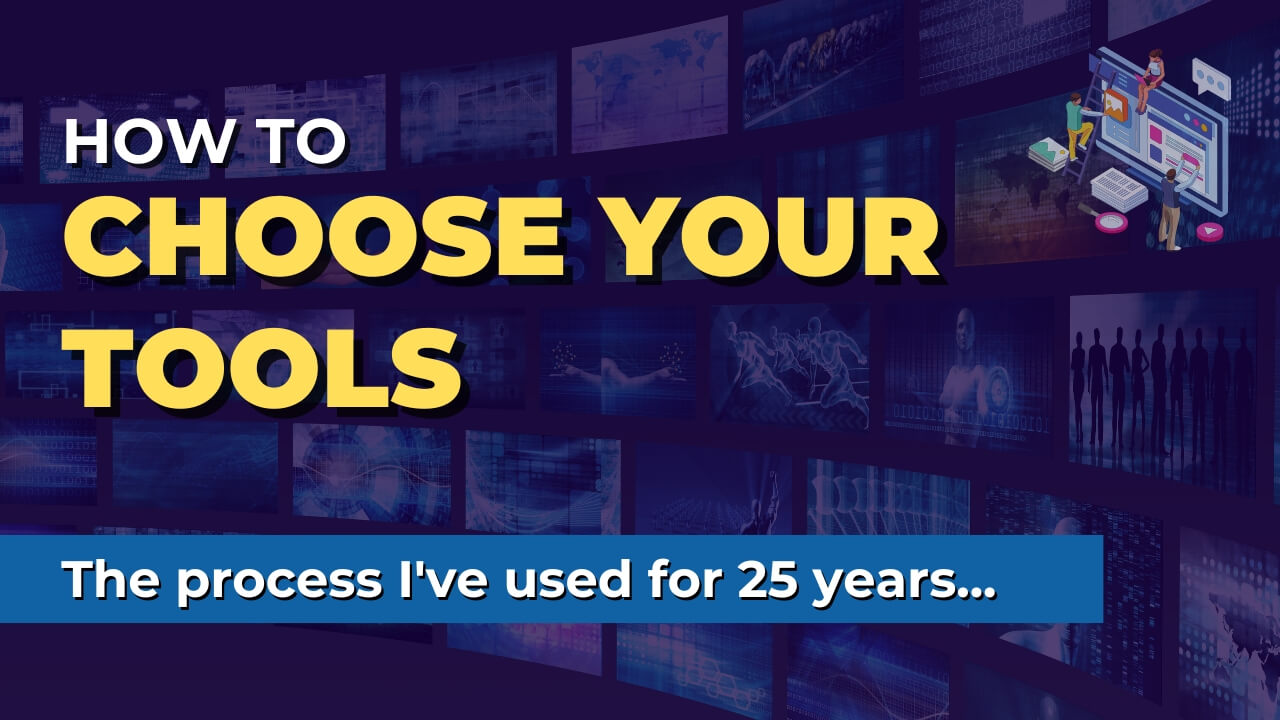How to choose your online business tools
In this article I’ll outline a simple but powerful process for selecting the right tools for your online business.
I have also created a free resource to help with this process and it will be available at the end of this post.
The process I’m outlining is valuable because it applies to any technical tool you need and it’s what I’ve used for over 25 years of technology consulting and making hundreds of millions of dollars worth of decisions. It consists of answering the following questions:
Do you need a tool?
The first and most important question you need to ask is whether you even need a tool in the given category or area. In online business there are hundreds of categories of tools and thousands of choices.
You certainly DO NOT need a tool from each one. Too many tools can dramatically slow your progress (and take a big chunk out of your budget)
How do you know if you need a tool?
It comes down to the time you are spending on a given activity and whether a tool will help you complete it faster. If you only need to schedule one or two meetings a week with a couple folks, investing time or money in a calendar scheduling tool or service is not worth it.

If you manage five concurrent projects with different teams of distributed co-workers, then a robust project management tool will be well worth it.
The best way to determine if you need one or more tools is keeping a detailed time log of your activities for at least a week.
This can be done in many ways but I recommend tracking 15 minute blocks combined with a running tally of repeat activities.
Let me break down what I mean by that. For the 15 minute tracking, use the countdown or stopwatch function on your phone (or find an app) that will beep every 15 minutes. Each time it does, quickly write down what you did during that time (very brief, couple word description, ex: conf call). For any activity that is starting to repeat (checking email, writing, etc.) start a simple list of those and tally or add a check mark each time you do that activity.
You really want to key in on things that are wasted time. Your time log might show that you spend six hours a week on project “coordination” calls where most of that time is just people reporting status which could easily be done inside of a project management tool.
Your time log will help you determine whether a tool can save you time in a given area. If your gut instinct is that a tool will save you at least one hour per week or more, it is worth exploring further. That’s not a yes, but it warrants moving to the next step which is getting specific about your requirements.
What are your requirements?
This is where most people fail, they do not list and prioritize their requirements before starting to evaluate options.
The marketing, feature bloat, and fancy user interfaces start seeming to be the most important thing and the next thing you know you have an expensive, difficult to learn, tedious to use tool that you feel guilty about not using a week after you get it and discard it.
Or worse, you like the tool, it’s really useful, but the darn thing won’t sync to your Android phone or doesn’t integrate with DropBox or some other important feature gap.
Take the time to think about your requirements and write them down. Once you have, rank or prioritize them. Later during your selection of candidates and evaluation process, you will be able to objectively score the options against your specific requirements.
I have created a free download which helps you capture, rank, and score all of your requirements. The link is at the end of this post.
This disciplined approach will help you make your own decisions instead of having to rely on reviews from others, whose requirements may not be the same as yours.
Here are some examples of the types of requirements you want to list. Let’s use the example of a task management application.
- Record tasks
- Record groups of tasks in projects
- Assign tags or categories to tasks
- Is it available on all the devices and platforms I need? (PC, Android Phone)
- Does it integrate with my other tools? (DropBox, Evernote)
- Does it integrate with Zapier or IFTTT? (in case you need to integrate with something the tool doesn’t natively)
- Must be easy to use, less than 10 seconds to open and enter a task
In addition to functional requirements (features and capabilities) you should also capture any relevant non-functional requirements.
A good example of a non-functional requirement would be the reputation or history of the company behind the tool. Especially in the productivity space, tools are relatively easy to create so new developers, companies, and apps pop up all the time.
If you are choosing a project management tool for you or your company to use, you may not want to select one that is written by a single independent developer who just launched version one a couple months ago.
On the other hand, if you are selecting a personal task management tool, that may be ok as the “switching cost” to move from one choice to another is not all that high.
Here are some other non-functional requirements to think about:
- How strong is the company?
- How many versions have they had and over what time frame?
- How quick do they add features?
- How good is their support?
- What type of support (if any) do they offer?
- Does support or maintenance cost extra?
What are the options or choices?
Once you have a prioritized list of requirements, you can start looking for candidates to evaluate.
If you pick a couple names from that list in your target category, you can then do a search for “review” or “comparison” to find even more tools in that category. I recommend finding at least five candidates.
How do I compare the options or choices?
Now it is time to compare your candidates.
This is where having a defined list of requirements really helps because you simply have to compare the feature list, spec sheet, or documentation of each candidate against your requirements.
Nearly all tools these days provide either a free demo account or a free usage tier which might have a limited feature set.
Ranking or comparing multiple tools can be as simple as recording a check mark if the requirement is met or a numerical ranking of how well each requirement is met.
The end result is you will have a matrix of requirements and candidate tools which will make clear which, if any, of the tools meet all of your requirements.
Check out the show notes for this episode for a free download to help you with this process. You can find the show notes at StrongStart.fm/podcast
How do I select the finalists?
The finalist may be an obvious choice (such as if only one candidate meets all your requirements) or you may have to go with subjective qualities if two or more meet all your requirements.
Maybe the user interface or colors of one appeal to you more.
As long as your requirements are met, beyond that any factor you use to make a final choice is fine.
An important but overlooked “requirement” is that you need to like your tools in order to want to use them and get value from them.
They key is to make sure your requirements are met!
How do I evaluate the finalists?
This is another step most people don’t do well, which is a semi-formal evaluation of the selected finalist.
In this step you actually validate that the tool meets your requirements (as opposed to trusting a spec sheet).
Almost every vendor provides a free trial period for their tools (or the tool itself is free anyway). These range from a couple days to a couple weeks. This is enough time to give the tool a test drive before committing to a purchase.
As you know from this series, the key to changing your results is to change your habits. For the trail period you need to make sure using the tool you are evaluating is added to you habit list and tracking.
Especially in the productivity space we are discussing, our current habits are deeply ingrained. As much as I know I should NOT use my email inbox as my task tracking system, I still fall back into that sometimes.
The next step is quickly learning the basics of the tool. For this you will use videos, tutorials, and so on that the maker of the tool provides. Focus on the features that support your high priority requirements.
Next, check YouTube for additional tutorial videos by other users of the tool in question.
In the first week of evaluating, make sure you have exercised the features supporting all of your high priority requirements.
This may mean creating test data or scenarios like a new project. As you are testing the functionality, keep notes in your requirements tracking document or spreadsheet of the good points and bad points about how the tool handles each requirement.
Definitely keep notes if you find situations where the tool does not provide an important feature. Small things here can be very important such as the number of clicks to create a new task to track.
Some tools may only require a click or two to do that while others may want five pieces of metadata entered for every new task.
Multiplied over dozens of tasks per day and hundreds per week, that may be a deal breaker.
The next step in your evaluation should be to let your social network or coworkers know you are using this tool and ask if any of them are as well. If yes, chat with them to see what their thoughts are and what they have learned.
At the end of the first week of your evaluating, spend some time with your requirements document and make sure you have completed the following tasks:
- Used the tool daily
- Used the tool for each of your tracked requirements
- Documented some pros and cons of how the tool works for each of your requirements
- Documented any missing features that are important to you
The above is a fairly objective, qualitative analysis.
The final step in the first week is capturing your feelings or instinct about the tool as well.
Was it a “chore” to use it or something you kept putting off? Or was the feeling closer to “yes this is definitely faster than my original method”.
Does the user interface appeal to you or do you “hate” their choice of color scheme? These sound simplistic but are quite important for long term adoption.
How do I make the decision?
At this point, you need to make a decision as to whether to continue your evaluation.
Personally, I would only stop at this point of the tools is not meeting any of your high priority requirements or if you have developed a significant negative feeling toward the tool.
At this point you will also have a feel for the return on investment meaning the time its taking to learn the tool and use it versus the value it is providing.
It typically takes weeks to change our habits, if not more, so you don’t want to give up too early but sometimes you can just “tell” that it’s not going to work so in that case go with your data and your gut and move on.
If you decide to keep evaluating the tool, then in the next week you will follow the same process but branch out and use more features of the tool if necessary or using it for a larger percentage of your needs.
If you decide this tool is not working for you, what you need to do is revise your requirements to add items addressing the gaps you found.
If you feel like two clicks or less to enter a task is important now, that becomes a requirement. With the updated requirements list you can go back to your candidate list and re-score the tools to pick the next candidate to test.
Once you have decided on the tool that works for you, the next step is to purchase that tool (if necessary) and make it a permanent part of your toolbox. This might mean now asking your virtual assistant to use the same tool or your project team, and so on.
Summary
If you follow the process outlined here, within one to two weeks you will have selected the tool that works for you in the given area or category you were evaluating.
Your choice will have been based on objective and subjective requirements specific to your needs, both functional and non-functional.
This structured process may take a bit longer, but in the end it will save significant time because you will not be jumping from choice to choice, spending time in a tool that you later find is missing critical features, and so on.
This process and it’s discipline will also serve you well on larger decisions.
Free Resource
To help you implement the evaluation process outlined in this post, I’ve created a free download for you: my Tool Requirement and Evaluation Template. This template will help you document, track, and score tools against your requirements.

